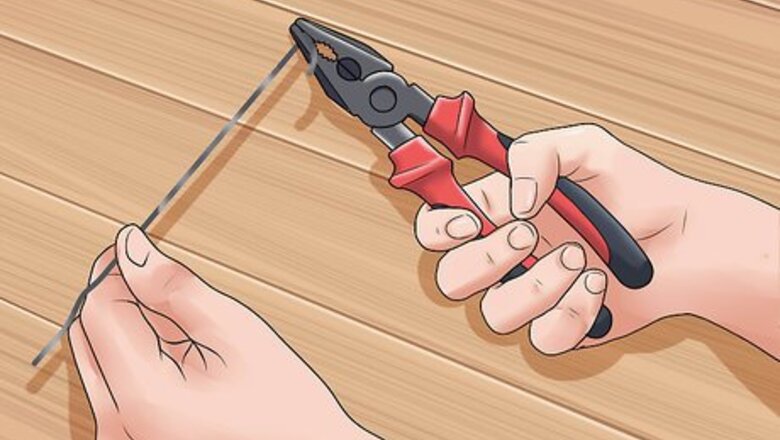
views
- Unclog a slow shower drain naturally by pouring 1 cup (272 g) of baking soda and 2 cups (473 mL) of boiling water down the drain to soften the clog.
- Wait 4-5 minutes, then pour another cup of baking soda and 1 cup (237 mL) of white vinegar down the drain. let the mixture fizz for about 15 minutes.
- Finish by flushing the drain with hot water from the faucet.
Unclogging a Shower Drain by Hand

Make a long wire hook with a wire hanger to remove clogs. If your shower drains slowly, it’s likely a result of clogged hair. Take a wire coat hanger and straighten it out into a long wire. Bend one end with pliers to make a small hook that will fit down the drain. You can also use a thick regular wire, bending the end to make a hook shape.

Slide the wire down the drain to hook and remove the clog. Unscrew or twist off the stopper from the drain. Shimmy the wire down the drain, using it to pull the clog out. You may need to dip down more than once to get all the hair. Once you’re able to remove it, dispose of the hair in the trash can. As you pull the hair up, use a utility knife to slice the hair off of the wire so you don’t need to untangle it. Test your shower or tub by running the water briefly. If it’s draining freely again, put the stopper back in. If your shower still isn’t draining properly, try these other methods down below or seek the assistance of a professional plumber.
Using Chemical Drain Cleaners

Purchase a chemical drain cleaner that's safe for your pipes. Products like gel cleaners and other commercial drain products can help you remove clogs from your drain. They work by dissolving the hair or excess product. It’s important to be careful with these products, as they’re powerful and can damage old pipes. Always read the bottle to ensure your product is safe for your pipes. Chemical cleaners may damage PVC, galvanized steel, copper, or iron pipes. Wear disposable gloves, safety goggles, and a mask to avoid touching or breathing in toxic chemicals. Never mix more than one type of drain cleaner simultaneously. This can expose you to toxic fumes.

Pour half a bottle down the drain, wait 30 minutes, then flush with hot water. Generally, start with half a bottle of chemical drain cleaner and wait 15 to 30 minutes. This will give the product time to trickle down the drain and attack whatever debris lies inside the pipes. Each drain cleaner may work differently, so follow the manufacturer’s instructions first. After waiting, run hot water down the drain to clear the chemicals and clog. If it’s not draining or only draining a little, use the rest of the cleaner bottle and test again.
Using Enzyme Dish Detergent
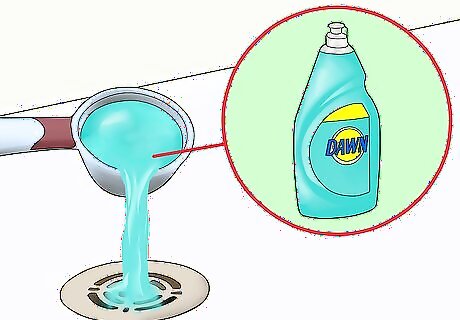
Pour 1 cup (237 mL) of enzyme detergent down the drain. A popular contender for chemical drain cleaners is enzyme-based liquid soaps. Enzymes are a common ingredient in popular liquid dish soaps like Dawn. Pour 1 cup (237 mL) of dish soap into your shower drain and let it sit for an hour. Then, flush the drain with hot water from the tap. Enzymes help speed up biological processes, like breaking down grease and clogs. This solution can create large amounts of suds, so be careful.
Using Boiling Water
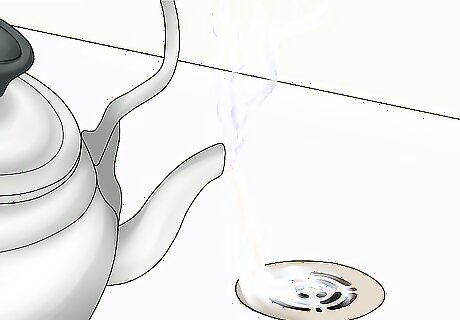
Pour a pot of boiling water down the drain slowly. If you have metal or CPVC pipes, boil a large pot of hot water on a stove or with a tea kettle. Then, carefully pour it down the drain in batches. Allow the heat to melt or break up the clog. This is ideal for minor blockages. You can also add salt to help the water boil faster. Salt is also abrasive and can scrape away at the debris that may be clinging to your pipes. If you have regular PVC pipes, boiling water could cause damage.
Using Baking Soda and Vinegar
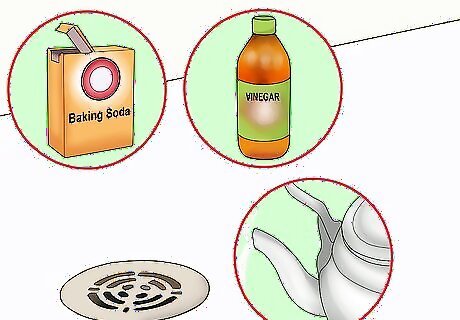
Pour a mixture of hot water, white vinegar, and baking soda down the drain. When used in conjunction, these ingredients can help break up clogs. Start by pouring a single cup (272 g) of baking soda down the drain, followed by 2 cups (473 mL) of boiling water. Allow it to sit for 4 or 5 minutes. Then, pour another cup of baking soda down the drain. With the stopper ready, pour in 1 cup (237 mL) of white vinegar. Close the stopper, allowing the baking soda and vinegar to foam. Once the mixture stops foaming, pour another cup of boiling water. Ensure you have CPVC or metal pipes, as boiling water may damage regular PVC pipes.
Using a Plunger

Use a toilet plunger to unclog the drain. Tape over any overflow holes with duct tape to get a better seal. Turn the faucet to cover the bottom of the plunger. Place the plunger over the drain and press up and down a few times. You may want to get a plunger specifically for this purpose. However, you can use a plunger you already have. Just thoroughly clean and sanitize it, or clean the bathtub afterward.
Using a Drain Stick or Auger
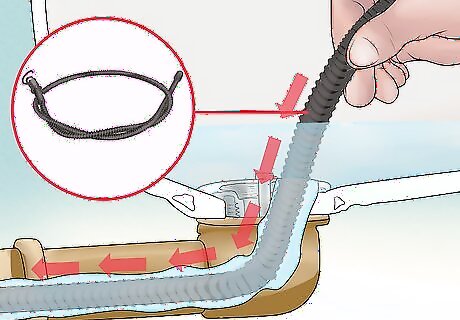
Thread a drain stick or auger into the shower drain. A drain stick, such as a Zip-it, is a mini snake that can remove clogs. Similarly, snakes or auger cables are for clogs deep in the pipes. Remove the strainer or overflow plate and thread the cable into the hole. Keep going until the line hits a clog, then stop pushing. You can purchase or rent an auger cable from your local home improvement store.
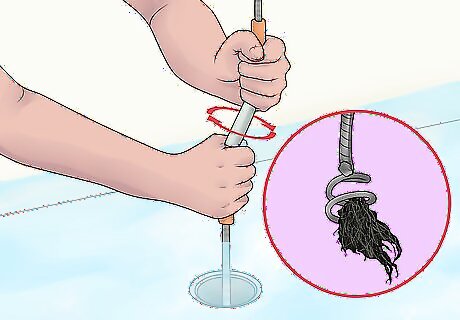
Latch onto the clog and twist or pull to remove it manually. Turn the handle of the auger cable clockwise. It will twist the end of the line into the clog. Keep pushing, pulling, and turning to get rid of it. If you’re using a drain snake, insert it until you feel the blockage and twist to remove it. You can also use a sewer rod, pushing it forward and back to break up the clog. If there’s a clog further down the line, you may need to feed in more auger cable to clear it thoroughly. Run hot water down the pipes to ensure it’s draining properly.
Preventing Clogged Shower Drains

Use drain strainers to minimize hair buildup. These strainers fit over the drain and catch any hair or similar debris from entering the drain. Remember to clean the drainers regularly to keep your shower draining properly.

Regularly flush your drain with hot water. While it may be hard to remember, get into the practice of running hot water down your drain after each shower or bath. You can leave the hot water running after you step out. This process will remove fresh buildup, reducing the chances of prolonged buildup sticking to your pipes.

Pour baking soda once a month. Dump a cup of baking soda down your drain, followed by a cup of boiling water. This will break down any minor clogs and keep your tub standing water-free! You can also add salt to a mixture of baking soda to prevent tough clogs.
Invest in regular pipe inspections by a professional plumber. Plumbing issues are no joke. So, to prevent costly repairs, hire a professional plumber to do a regular maintenance check once a year or once per season if you can afford it. A plumber may be able to identify underlying issues contributing to clogged pipes.
















Comments
0 comment